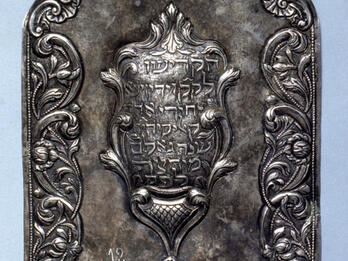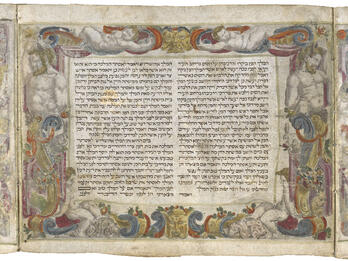Magen ve-tsina (Shield and Bulwark)
The ten halakhic questions raised by a certain individual directed against the Oral Law, and several of the commentaries upon it, have reached us. I have not needed to carry out a great deal of research to find answers to them, for he is not the first to have raised such queries, nor is it the first time that they—and indeed, more than these—have been raised. Our predecessors have already provided adequate—and indeed more than adequate—responses to them, for these sects came into existence toward the end of the era of the Second Temple, and after the destruction, and together they contended perpetually with our sages, in particular in the time of Rav Yehudah Ga’on, as has been mentioned by R. Abraham ibn Daud, in his work Shalshelet ha-kabalah [The Chain of Tradition]. There was, [he writes], a certain learned scholar by the name of Anan, who, because he had not been appointed as exilarch, harbored impure thoughts in his heart, and led the Jewish people astray, urging them to turn away from the tradition of the prophets and the sages—and he wrote books and accumulated many disciples. Notwithstanding all this, Almighty God was steadfast in supporting the truth of His Torah, to ensure that they failed to put down roots in the world, and our sages, the rabbis, invariably prevailed. It is, truth to tell, a most wondrous thing that despite the entire exile and the tribulations suffered by the Jewish people, notwithstanding the [sages’] injunctions and the safeguards they erected around the Torah, which were difficult to observe, even as several of them were not so logical, they attained wide publicity and were accepted throughout the diaspora, and the opponents were driven away and became nothing. And those of the Jewish people who do not believe in and observe every law and every one of the minutest details of the laws of the Oral Torah are but one in a thousand! (And I, the insignificant one, myself uphold this truth all the more readily, since in regard to all the uncircumcised scholars, notwithstanding their railing against our sacred Talmud, not a single Christian writer upholds this evil belief of the Karaites directed against the Oral Torah—on the contrary, they all pour scorn on it, and say that the Oral Torah is truth and righteousness; and this is, truth to tell, divine providence, as the Christians, in line with their suppositions, should have supported that belief). There is no difference—save for a few local customs—among Ashkenazim, Sephardim, and those from foreign parts insofar as the liturgy is concerned, nor do their various stringencies have any effect with regard to talmudic law—for they prostrate themselves and bend the knee to everything emanating from the Gemara; and this alone ought to have sufficed to shut the mouth of any dissenter!
And accordingly, we could have said to this questioner that he should go and read the introduction of R. Abraham Ibn Ezra’s preface to his commentary on the Torah, and various sections of his commentaries, and section three of the Kuzari [by Judah Halevi], where he would find the answers to his imaginings. However, to keep him content for the time being, we shall reply to his seventh query, which, in its generality, is aimed at overthrowing the fundamental basis of the Oral Torah that we currently have in our possession. It would appear to us that by resolving this question, all the other queries he has raised and may ever potentially be capable of raising, will also be resolved—though we will not maintain silence about responses to the remaining questions. Accordingly, at the very outset, we shall cite and pursue the path of the two authors mentioned above, adding a little of our own material, so this may serve as a letter of response, rather than an entire work, such as was indeed required; and we shall first explain the necessity for the existence of an Oral Torah on three separate accounts.
Credits
Leone Modena, Ma’amar magen vetzina (Shield and Bulwark) (Breslau: H. Zultsbakh, 1856), fols. 3b ff.
Published in: The Posen Library of Jewish Culture and Civilization, vol. 5.




